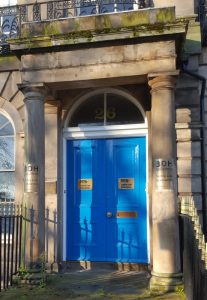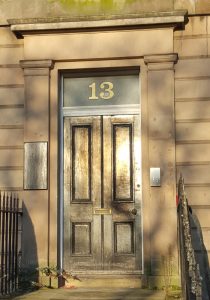Why Important
Badly placed, sized or coloured business signage can seriously undermine a hertiage area. Yet busineses do need to show where they are located. Within a conservation area, and especially on Listed buildings, there are rules regarding business signage. Failure to follow these rules can prove to be a very expensive, legal, hassel for the business and also the owner of the Listed building.
What to look for
 Nameplates should be brass, with incised lettering. These were originally filled with black wax, but are now filled with black paint.
Nameplates should be brass, with incised lettering. These were originally filled with black wax, but are now filled with black paint.
Small plates for residents’ names are screwed to the backplate of the bell pull outside the door to the common stair or the flat.
Larger brass plates, used by advocates and other professionals, are usually screwed to the mid-rail ( muntin ) of the door.
How to fix
 When large new nameplates are required by companies these should be placed on the wall beside the door and should exactly cover the face of the stone to which they are fixed.
When large new nameplates are required by companies these should be placed on the wall beside the door and should exactly cover the face of the stone to which they are fixed.
Usually the place these were used is still visible, and the location, size, and shape of the original plate should be used.
Fixings should always be brass or stainless steel, either secret fixed or with brass covers, and must be well clear of edges of the stone. To reduce costs, the plates could be of cast or sheet brass covering a timber frame, to resemble a cast plate.
The plate may incorporate the bell pull, bell push or entryphone.
Avoiding creating problems
Do not use plastic or imitation ‘brass’ effect name plates (or entryphones), as they distract from the façade of the whole building, especially at the entrance to a Listed property.
